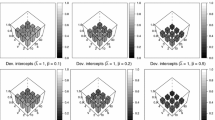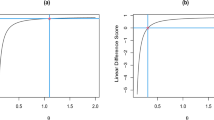Abstract
Estimating the number of species in a biological community based on a multinomial sample of individual organisms is a classical problem in statistical ecology. A central issue in parametric estimation is the specification of a model of the relative abundances of species given their number. A common approach to this problem is to assume that relative abundances follow a symmetric Dirichlet distribution. This is mathematically convenient but is unconnected to work by ecologists on abundance distributions in real communities. In this article we describe ML estimation based on the sequential broken stick model that has been proposed for abundances. This model is defined mechanistically, requiring that the likelihood be approximated numerically. For this to be feasible, the likelihood must be based on a small number of summary statistics. We present simulation results that show that the observed number of species and the observed number of species represented by a single individual is a reasonable set of summary statistics on which to base estimation. We apply the method to two published data sets, one involving insect species on Mount Kenya and the other involving spider species in an Appalachian forest.
Similar content being viewed by others
References
Boender, C. G. E., and Rinnooy Kan, A. H. G. (1987), “A Multinomial Bayesian Approach to the Estimation of Population and Vocabulary Size,” Biometrika, 74, 849–856.
Bunge, J., and Fitzpatrick, M. (1993), “Estimating the Number of Species: A Review,” Journal of the American Statistical Association, 88, 364–373.
Chao, A. (1984), “Nonparametric Estimation of the Number of Classes in a Population,” Scandinavian Journal of Statistics, 11, 265–270.
— (2005), “Species Estimation and Applications,” in Encyclopedia of Statistical Sciences (2nd ed.), Vol. 12, eds. N. Balakrishnan, C. B. Read, and B. Vidakovic, New York: Wiley.
Chao, A., and Lee, S.-M. (1992), “Estimating the Number of Classes via Sample Coverage,” Journal of the American Statistical Association, 87, 210–217.
Coddington, J. A., Young, L. H., and Coyle, F. A. (1996), “Estimating Spider Species Richness in a Southern Appalachian Cove Hardwood Forest,” Journal of Arachnology, 24, 111–128.
Diggle, P. J., and Gratton, R. J. (1984), “Monte Carlo Methods of Inference for Implicit Statistical Models,” Journal of the Royal Statistical Society, Ser. B, 46, 193–227.
Lewins, W. A., and Joanes, D. N. (1984), “Bayesian Estimation of the Number of Species,” Biometrics, 40, 323–328.
Marjoram, P., Molitor, J., Plagnol, V., and Tavaré, S. (2003), “Markov Chain Monte Carlo Without Likelihoods,” Proceedings of the National Academy of Sciences, 100, 15324–15328.
Murtaugh, P. A., and Birkes, D. S. (2006), “An Empirical Method for Inferring Species Richness From Samples,” Environmetrics, 14, 129–138.
Nee, S., Harvey, P. H., and May, R. M. (1991), “Lifting the Veil on Abundance Patterns,” Proceedings of the Royal Society, Ser. B, 293, 161–163.
Siegel, A. F., and Sugihara, G. (1983), “Moments of Particle Size Distributions Under Sequential Breakage With Applications to Species Abundance,” Journal of Applied Probability, 20, 158–164.
Solow, A. R. (1994), “On the Bayesian Estimation of the Number of Species in a Community,” Ecology, 75, 2139–2142.
Sugihara, G. (1980), “Minimal Community Structure: An Explanation of Species Abundance Patterns,” American Naturalist, 116, 770–787.
Sugihara, G., Bersier, L.-F., Southwood, T. R. E., Pimm, S. L., and May, R. M. (2003), “Predicted Correspondences Between Species Abundances and Dendograms of Niche Similarities,” Proceedings of the National Academy of Sciences, 100, 5246–5251.
Zhang, H., and Stern, H. (2005), “Investigation of a Generalized Multinomial Model for Species Data,” Journal of Statistical Computation and Simulation, 5, 347–362.
Author information
Authors and Affiliations
Corresponding author
Rights and permissions
About this article
Cite this article
Solow, A.R., Smith, W.K. Estimating species number under an inconvenient abundance model. JABES 14, 242–252 (2009). https://doi.org/10.1198/jabes.2009.0015
Received:
Revised:
Issue Date:
DOI: https://doi.org/10.1198/jabes.2009.0015




